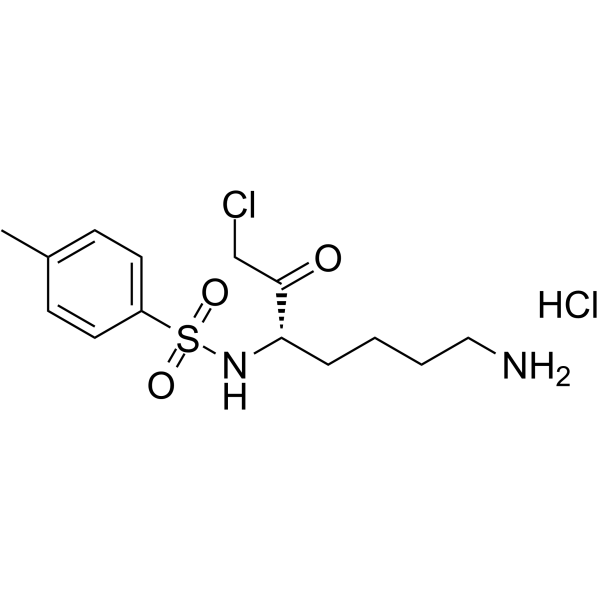上海金畔生物科技有限公司为生命科学和医药研发人员提供生物活性分子抑制剂、激动剂、特异性抑制剂、化合物库、重组蛋白,专注于信号通路和疾病研究领域。
N-alpha-Tosyl-L-lysine chloromethyl ketone hydrochloride 纯度: 98.02%
N-alpha-Tosyl-L-lysine chloromethyl ketone (TLCK) 是一种胰蛋白酶样蛋白酶抑制剂,使 HeLa 细胞对 Fas 介导的细胞死亡敏感。

N-alpha-Tosyl-L-lysine chloromethyl ketone hydrochloride Chemical Structure
CAS No. : 4272-74-6
| 规格 | 价格 | 是否有货 | |
|---|---|---|---|
| 50 mg | ¥2700 | 询问价格 & 货期 | |
* Please select Quantity before adding items.
N-alpha-Tosyl-L-lysine chloromethyl ketone hydrochloride 相关产品
•相关化合物库:
- Bioactive Compound Library Plus
- Anti-Cancer Compound Library
| 生物活性 |
N-alpha-Tosyl-L-lysine chloromethyl ketone (TLCK), a trypsin like protease inhibitor, sensitizes HeLa cells to Fas-mediated cell death. |
||||||||||||||||
|---|---|---|---|---|---|---|---|---|---|---|---|---|---|---|---|---|---|
| 体外研究 (In Vitro) |
N-alpha-Tosyl-L-lysine chloromethyl ketone exhibits an inhibitory effect on IFN-γ activities. The effect of TLCK is studied on the IFN-γ sensitization of HeLa cells towards cell death mediated by anti-Fas. Lower concentration of anti-Fas (10 ng/mL) are used to examine the interaction among the three effectors simultaneously, that is, anti-Fas, TLCK and IFN-γ. TLCK by itself up to 50 μM concentration exhibits a small decrease in cell viability. Beyond 50 μM, a dose dependent decrease in cell viability is observed. IFN-γ slightly reduces cell viability on its own. Addition of anti-Fas (10 ng/mL) results in a slight decrease in cell survival, which is enhanced more than additively in the presence of TLCK, most prominently between 50 and 100 μM. Upon addition of both anti-Fas and IFN-γ, a decrease (≈46%) in cell viability is observed. Moreover, the decrease in cell survival is further enhanced upon addition of higher concentrations of TLCK, 25 μM and more[1]. Shanghai Jinpan Biotech Co Ltd has not independently confirmed the accuracy of these methods. They are for reference only. |
||||||||||||||||
| 分子量 |
369.31 |
||||||||||||||||
| Formula |
C14H22Cl2N2O3S |
||||||||||||||||
| CAS 号 |
4272-74-6 |
||||||||||||||||
| 运输条件 |
Room temperature in continental US; may vary elsewhere. |
||||||||||||||||
| 储存方式 |
-20°C, sealed storage, away from moisture *In solvent : -80°C, 6 months; -20°C, 1 month (sealed storage, away from moisture) |
||||||||||||||||
| 溶解性数据 |
In Vitro:
DMSO : 250 mg/mL (676.94 mM; Need ultrasonic) H2O : 100 mg/mL (270.78 mM; Need ultrasonic) 配制储备液
*
请根据产品在不同溶剂中的溶解度选择合适的溶剂配制储备液;一旦配成溶液,请分装保存,避免反复冻融造成的产品失效。 In Vivo:
请根据您的实验动物和给药方式选择适当的溶解方案。以下溶解方案都请先按照 In Vitro 方式配制澄清的储备液,再依次添加助溶剂: ——为保证实验结果的可靠性,澄清的储备液可以根据储存条件,适当保存;体内实验的工作液,建议您现用现配,当天使用; 以下溶剂前显示的百
|
||||||||||||||||
| 参考文献 |
|
| Cell Assay [1] |
HeLa cell line (human cervical cancer cells) is cultured in DMEM supplemented with 10% fetal bovine serum (FBS), L-glutamine (300 mg/L), penicillin (100 U/ml) and streptomycin(100 μg/ml) at 37°C in 5% CO2. HT-29 cell line (human colorectal adenocarcinoma) is cultured in RPMI supplemented with 10% fetal bovine serum (FBS), L-glutamine (300 mg/L), penicillin (100 U/mL) and streptomycin (100 μg/mL) at 37°C in 5% CO2. The cells are split every second day to keep the cell growth in logarithmic phase. The cells are routinely tested for mycoplasma. The cells are treated with different concentrations of TPCK or TLCK (5, 10, 25, 50, 100, 150, and 200 μM) for 30 min and/or with different concentrations of IFN-γ for 2 h followed by treatment with different concentrations of anti-Fas for 2 or 4 days for each specific experiment. The control cells are treated with the respective vehicle only. Cell viability analysis of HeLa and HT-29 cells is assessed by their XTT reduction activity. 100 µL of 2×104 cells/mL is incubated with treatments at the indicated time. At the end of the incubation period, 25 µL of 1 mg/mL XTT solution (containing 0.2 mM phenazine methosulphate (PMS) is added and the cells are incubated for an additional 1 h. The OD values are measured using an ELISA reader at 450 nm with a reference wavelength of 650 nm[1]. Shanghai Jinpan Biotech Co Ltd has not independently confirmed the accuracy of these methods. They are for reference only. |
|---|---|
| 参考文献 |
|
所有产品仅用作科学研究或药证申报,我们不为任何个人用途提供产品和服务
